What Is a Fact Family?
A fact family in math is a group of math facts created using three numbers. Numbers also have relationships, just like members of a family. These relations between numbers are well described using fact families.
Recommended Games
Fact Family Definition
A fact family can be defined as a collection of math facts that express the relation between the same set of numbers. It is also known as a “number family” and generally uses three numbers.
It helps to understand basic arithmetic operations (addition, subtraction, multiplication, and division) and solve their problems.
Recommended Worksheets
Fact Family Triangle
Fact families are usually represented in the form of a triangle, as shown in the below image. The three numbers forming the fact family are written in the three corners (near the vertices) of the triangle.
The operation’s sign connecting the three numbers is usually written in the middle. For the addition fact family, the sum of the numbers is usually written at the top vertex, and the numbers being added are written at the vertices at the bottom.
Take a look at the fact family triangle with fact family numbers 2, 5, 7.
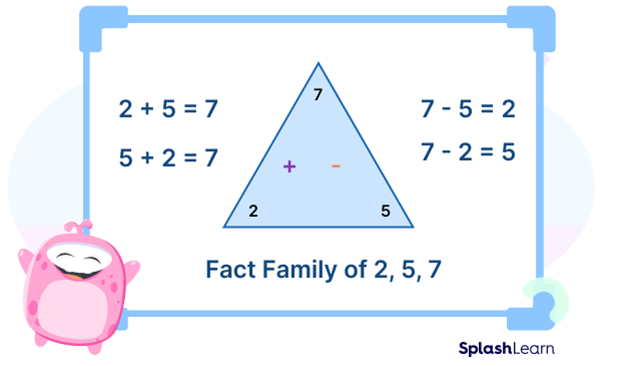
Fact families can be used for solving basic arithmetic equations involving addition, subtraction, multiplication, and division. Let’s look into two types of fact family examples.
Addition and Subtraction Fact Family
In an addition and subtraction fact family, the three numbers will have two addition and two subtraction relationships.
Here, for instance, a fact family has been created using the numbers 12, 8, and 4, where 12 is the total number of crayons, out of which 8 are yellow and 4 are red.
The four relationships here are as follows.
- $4 + 8 = 12$
- $8 + 4 = 12$
- $12$ $–$ $8 = 4$
- $12$ $–$ $4 = 8$
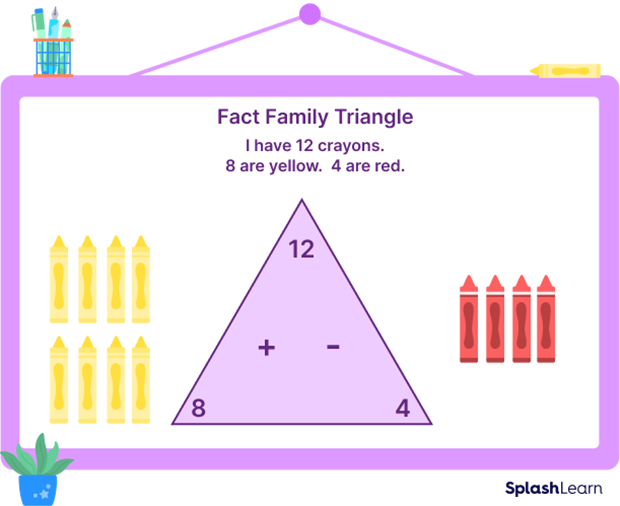
Let’s take another example with the numbers 9, 4, and 5. Here, 4 and 5 are parts, while 9 is the whole.
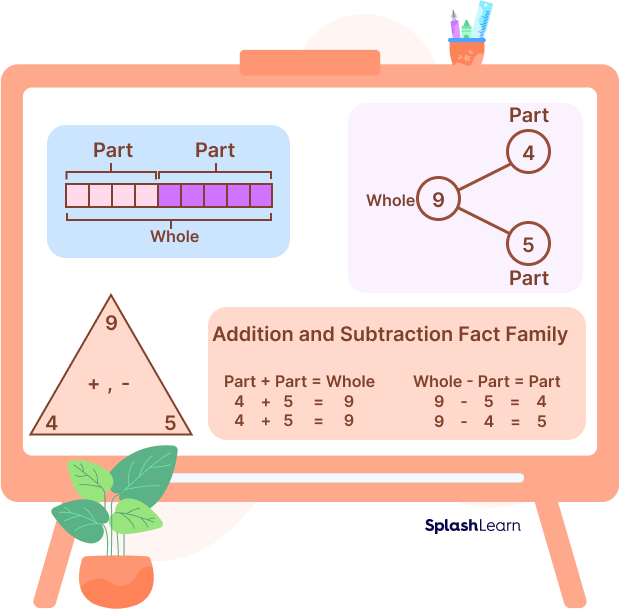
Multiplication and Division Fact Family
In a multiplication and division fact family, the three numbers will have two multiplication and two division relationships.
For instance, let’s consider an art class where 8 students sit at 4 tables in groups of 2. Four relations formed using the numbers 2, 4, 8 are are:
- $4 \times 2 = 8$
- $2 \times 4 = 8$
- $8 \div 4 = 2$
- $8 \div 2 = 4$
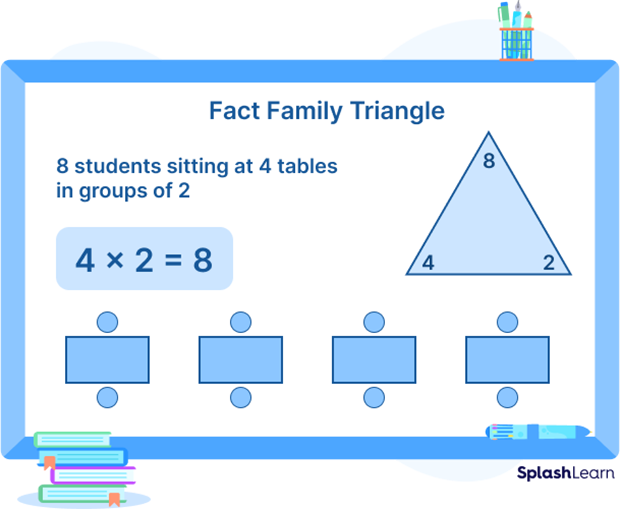
Let’s take another example. Here, 4 and 3 are parts, while 12 is the whole.
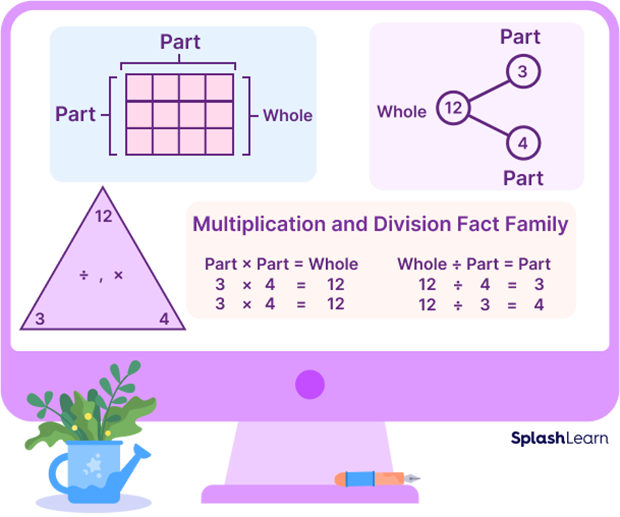
Fun Fact!
- One exciting thing about fact families is that they represent the inverse relationship between operations.
Get ready to rap!!

Three numbers—it’s a family bond!
Just multiply or divide to respond.
Or whether you add or subtract,
In the end, you get a family of facts!
Conclusion
A fact family is a fundamental concept that lets the brain think of various arithmetic operations and combinations of numbers. This will help in developing problem-solving skills and enhance analytical thinking capabilities.
Solved Examples on Fact Family
- Form two addition and subtraction equations for the fact family diagram given below.
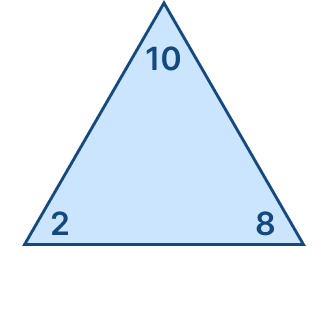
Solution: The three numbers 10, 2, and 8 form an addition and subtraction fact family. The equations for addition are as follows:
Addition equations
- $8 + 2 = 10$
- $2 + 8 = 10$
The equations for subtraction are as follows:
Subtraction equations
- $10$ $–$ $2 = 8$
- $10$ $–$ $8 = 2$
2. Form multiplication and division equations for the fact family triangle given below.
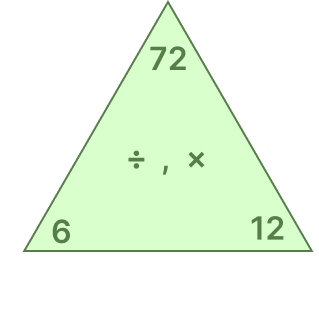
Solution:
Multiplication equations
$6 \times 12 = 72$
$12 \times 6 = 72$
Division equations
$72 \div 6 = 12$
$72 \div 12 = 6$
3. Form a fact family triangle with numbers 4, 5, and 20. Write the equations.
Solution:
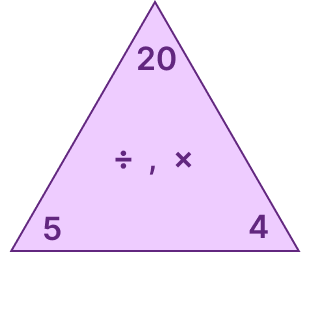
Multiplication equations
$4 \times 5 = 20$
$5 \times 4 = 20$
Division equations
$20 \div 4 = 5$
$20 \div 5 = 4$
4. Complete the fact family triangle and equations for the three numbers: 3, 6 and 9.
Solution:
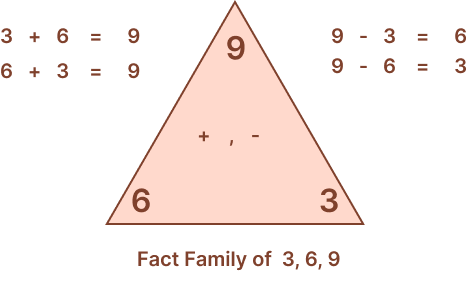
The equations are as follows:
- $3 + 6 = 9$
- $6 + 3 = 9$
- $9$ $–$ $3 = 6$
- $9$ $–$ $6 = 3$
Practice Problems on Fact Family
Fact Family
What’s the missing relation?
$2 + 8 = 10$
$8 + 2 = 10$
$10 – 2 = 8$
?
This is an addition and subtraction fact family, where two addition sentences are given in the problem statement with one subtraction sentence. The missing subtraction sentence that matches the fact family of three numbers 2, 8, and 10 is $10$ $–$ $8$, equal to 2.
Which math operation does NOT belong in the family of math facts you can create from the numbers 8, 5, and 13?
8, 5, and 13 form an addition and subtraction fact family, where the possible operations are as follows.
$8 + 5 = 13$
$5 + 8 = 13$
$13$ $–$ $5 = 8$
$13$ $–$ $8 = 5$
The odd one is option b, i.e., $8 \times 5 = 40$, which does not belong to the fact family.
Find the missing number in the multiplication and division fact family: 2, 20, ?
2, 10, and 20 form a multiplication and division fact family where the two possible division operations are $20 \div 10 = 2$ and $20 \div 2 = 10$.
Frequently Asked Questions on Fact Family
How can we efficiently teach fact family to children?
Instead of handing out math worksheets, play a game with your children using fun things like jelly beans. Give jelly beans in a set of three numbers, say 2, 3, and 5. Ask them to create an addition and subtraction fact family using the jelly beans. Repeat for multiplication and division fact family.
How are fact families and arrays related?
Arrays are visual representations of a fact family in the form of symmetry. For example, in a fact family of 4, 3, and 12, twelve students are made to stand in 3 rows and 4 columns, forming a $3 \times 4$ array.




































